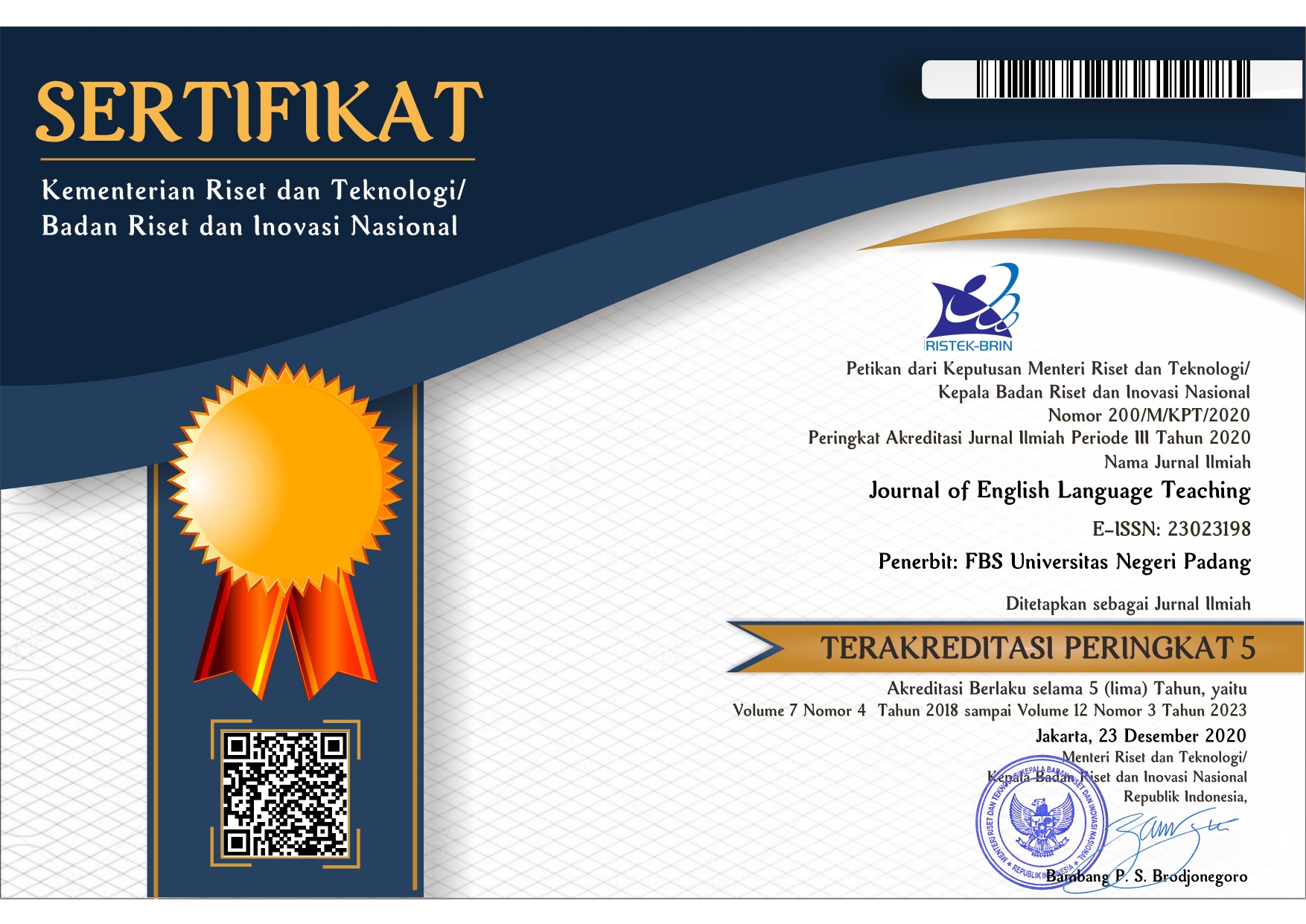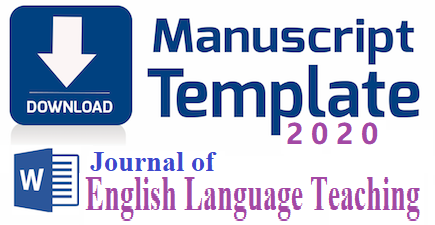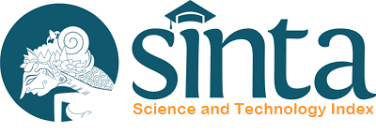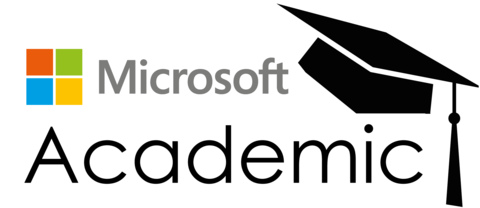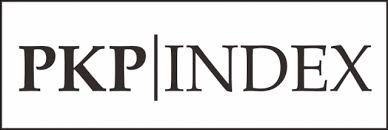THE QUALITY OF POWERPOINT SLIDES MADE BY ENGLISH DEPARTMENT STUDENTS OF PADANG STATE UNIVERSITY IN PRESENTING ENGLISH COURSE MATERIALS
 ), DON NARIUS(2),
), DON NARIUS(2), (1) Universitas Negeri Padang
(2)
 Corresponding Author
Corresponding Author
Copyright (c) 2018 Journal of English Language Teaching
DOI : https://doi.org/10.24036/jelt.v6i1.9723
Full Text:
 Language : en
Language : en
Abstract
This research is a descriptive research that is intended to reveal the quality of PowerPoint slides made by English Department of Padang State University in presenting English course materials. The data in this research were obtained from the archives of PowerPoint which is already presented in course TEFL course (Teaching English as Foreign Language) by educational-program students. Up until now, the software which is known as PowerPoint has been widely used to assist the learning process in academic settings ranging from the primary school level to the higher level such as university. Thus, a research on the use of this software academic fields needs to be conducted. The instrument used in this study is an analytic rubric. After conducting the research, the quality of students’ PowerPoint slides in term of the content accuracy was still in average. Since the students were already in the final year, the ability to understand the text about the course materials is expected to be better. Nevertheless, although the final score was considered as an average, there are still some students who presented the course materials incorrectly. In other words, the information they presented was different from the original source given by the instructors.
Keywords
References
Anderson, Mark. And Kathy Anderson. 1998. Text Type in English 2. South Yarra: Macmillan.
Anderson, Mark. And Kathy Anderson. 1998. Text Type in English 3. South Yarra: Macmillan Education Australia PTY LTD.
Barnum, Carol M. 1994. “Collaborative Writing in Graduate Technical Communication: Is There a Difference?”. Journal of Technical Writing and Communication. Vol. 14, No. 9, 1994.
Binangkit, Reni., et al. 2013. The Use of Demonstration Method in TeachingWritingProcedure Text at Ninth Grade of SMPNegeri 1 Darma. Gunung Jati Cirebon. Retrived on October 15th, 2015. www.google.com/m?q=PAPER+%28RENI+BINANGKIT%29_3.pdf&client=msope ra-mini-android&channel=new.
Blanton, L.L. 1992. “Reading, Writing, and Authority: Issues in Developmental ESL”. College ESL. Vol. 6, No. 2, 1992.
Boardman, Cynthia. A, and Frydenberg, Jia. 2002. Writing to Communicate: Paragraphs and Essays. University of California, San Fransisco: Longman Brown, James W., et al. 1983. AV Instruction: Technology, Media and Methods. Arlington: McGraw-Hill.
Derewianka, Beverly. 2004. Exploring How Text Work. Sydney: Primary English Teaching Association.
Djamarah, SyaifulBahri. 2000. Guru danAnakDidikdalamInteraksiEdukatif. Jakarta: RinekaCipta.
Duin, Ann Hill. 1986. "Implementing Cooperative Learning Groups in theWriting Curriculum".Journal of Teaching Writing. Vol. 9, No. 1, 1986.
Gerot, L. And P. Wignell. 1994. Making Sense of Functional Grammar. Sydney: Gerdstabler.
Graham, Steve and Perin Dolores. 2007. Writing Next : Effective strategies to Improve Writing of Adolescents in Middle and High schools. New York: Carnegie Corporation.
Harmer, Jeremy. 2004. How to Teaach Writing. New York: Pearson Education ESL.
Hedge, Tricia. 2005. Writing. Oxford: Oxford University Press.
Hyland, Ken. 2008. “Academic Clusters: Text Pattering in Published and Postgraduate Writing”. International Journal of Applied Linguistics. Vol. 3, no. 2, 2008.
Jacob, Evelyn. 1999. Cooperative Learning in Context: An Education Innovation in Everyday Classroom. Albany:State University of New York Press.
Kemper, D., et al. 1914. Writer Express: Handbook for Young Writers, Thingkers, and Learners. Wisconsin: Write Source Education.
Knapp, Peter and MeganWatkins. 2005. Genre, Text,Grammar: Technologies for Teaching and Assessing Writing. Sydney:University of Wales Press.
Mangubhai, Francis and Ruth Pitchard. 1996. English on Cue-Developing Skill in
English Language. Quensland: USQ Press.
Morgan, Barton, et al. 1976. Method in Adult Education (3rd Ed). Danville: The Interstate Printers & Publisher Inc.
Mundi, N. E. 2006. “The State of Students’AcademicAchievement in Secondary School Agricultural Science in Kogi State”. Teacher Education Journal (TEJ).Vol. 8, No. 3, 2006.
Paltridge, B. 1996.“Genre,Text Type, and The Language LearningClassroom”.ELT Journal.Vol. 50, No. 3, July 1996.
Perkins, Ray. 2005. “Teaching Writing”. Retrieved on October 15th, 2015. From: http://wac.colostate.edu/journal/vol9/perkins.pdf.
Peregoy, S. F., & O. F. Boyle. 2001. Reading, writing, and learning in ESL: A Resource Book for K-12 Teachers. New York: Longman.
Siregar, Iwali Kumarega. Tiarina, Yuli. 2013. Creating Media To Teach Speaking By Using Microsoft Power Point. ELT Journal 1(3), 18-21
Sneedden, David. 1917. Problems of Secondary Education. Boston: Houghton Mifflin.
Triyono, Pamuji. 2012.ManajemenPenyelenggaraan Program Keahlian TataBogaSekolahMenengahKejuruanNegeri 1 Kalasan.Unpublished Thesis.UNY.
Verrderber, Rudolph F. And Kathleen. 2003. Effectivs Speaking Twentieth Edition. New York: Thomson Learning Inc.
White, E. 1985. Teaching and Assessing Writing. San Francisco: Jossey-Bass.
 Article Metrics
Article Metrics
 Abstract Views : 302 times
Abstract Views : 302 times
 PDF Downloaded : 54 times
PDF Downloaded : 54 times
Refbacks
- There are currently no refbacks.
Copyright (c) 2018 Journal of English Language Teaching

This work is licensed under a Creative Commons Attribution-NonCommercial-NoDerivatives 4.0 International License.

